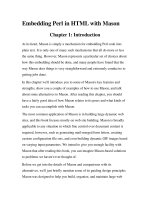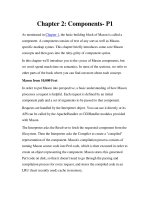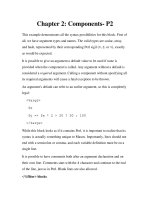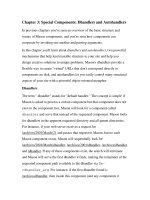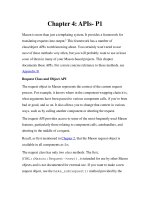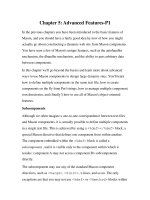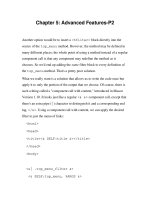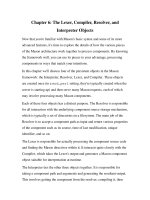Energy aware congestion adaptive randomized routing in manets with sleep mode
Bạn đang xem bản rút gọn của tài liệu. Xem và tải ngay bản đầy đủ của tài liệu tại đây (315.55 KB, 7 trang )
International Journal of Computer Networks and Communications Security
VOL. 4, NO. 5, MAY 2016, 146–152
Available online at: www.ijcncs.org
E-ISSN 2308-9830 (Online) / ISSN 2410-0595 (Print)
Energy Aware Congestion Adaptive Randomized Routing in
MANETs with Sleep Mode
JINESH KUMAR SINGH1, PRASUN CHAKRABARTI2 and MUKESH KALLA3
1, 3
2
Assistant Professor, Department of CSE, Sir Padampat Singhania University, Udaipur (Raj.)
Professor and Head, Department of CSE, Sir Padampat Singhania University, Udaipur (Raj.)
E-mail: , ,
ABSTRACT
MANETs are typically limited in resources like available wireless transmission bandwidth, available node
battery power etc which makes the routing complex compare to the normal infrastructure based wireless
network. Node mobility also makes the routing decision further hard. A packet drop in such network can be
due to: Node Mobility, Congestion on network or node failure (energy drain or hardware failure). The
MANETs nodes are typically running on battery power and energy issue is one major concern in MANET
operation. If a node’s battery power drains completely, the node goes to power off state and thus the
connectivity of the network is affected and network life time is reduced. The other concern in MANETs is
Congestion. When a portion of a network has high incoming load then its capacity, packets start to drop and
experience higher delay than normal, which reduces the throughput of the network and negatively affects
the QoS parameters of the network. Congestion also causes low utilization of the network resources. In
congestion, with each packet drop the energy used in transmission and reception is wasted. Thus higher
energy efficiency can only be achieved, if energy issue and congestion issue are addressed together. This
paper proposes a new Energy aware congestion adaptive randomized routing algorithm (EACAR-AODV)
which addresses both the energy and congestion issue to achieve higher energy efficiency and QoS
parameters. The proposed method is based on AODV and applies energy policy to include only high energy
node, Random routing packet drop policy to control the RREQ flood to reduce energy consumption and
congestion during path setup, and applies congestion policy based on current queue size of the node to find
an alternate non-congested path. The proposed protocol is implemented in NS2 network simulator and
compared with traditional AODV. The results show an improvement in both QoS parameters and Energy
efficiency without introducing significant overhead.
Keywords: Congestion Adaptive, Energy Aware, EACAR-AODV, Sleep Mode, Randomized MANET
Routing.
1
INTRODUCTION
The wireless technology allows users to
exchange information and services without
concerning connectivity with a pre established
resource setup. This allow users to use network
resources and services from any location such as
internet from mobile phone, laptops etc. The
wireless network with a central base station is
called infrastructure network and requires the user
to remain in the coverage area of the central base
station. The other type is Ad hoc network where the
infrastructure is not required and each node uses
cooperative routing process to communicate with
each other. These networks are generally referred to
as MANETs (Mobile Ad-hoc Networks). Such
networks are composed of an autonomous group of
mobile users who communicate through relatively
bandwidth constrained wireless links. The benefit
of MANETs is that it is easier to establish and do
not require any infrastructure resources. This makes
them highly dynamic and deployable in many
applications like human or nature induced disasters,
battlefields, meeting rooms where either a wired
network is unavailable or deploying a wired
network is inconvenient.
147
J. K. Singh et. al / International Journal of Computer Networks and Communications Security, 4 (5), May 2016
The packet drop in MANETs can be caused by
many reasons including link break due to mobility,
congestion in network, no remaining node power.
Due to mobility of nodes the network topology
changes frequently over time [1]. The problem with
node mobility is that it makes routing decision
complex. Consistent network information cannot be
maintained easily.
MANETs consist of battery
operated devices, which requires energy
conservation during the routing process. To
increase the lifetime of an ad hoc network, it is
essential to lengthen each individual node life
through minimizing the total transmission energy
consumption for each communication request.
Therefore, an efficient routing protocol must satisfy
that the energy consumption rate at each node is
evenly distributed so that low energy node is not
selected in the routing path [2].
Congestion is one another related issue in
MANET. When load on a node or link is increased
beyond its capacity, packets starts to drop because
of buffer overflow. Also packets suffer from high
delay in congested route. The main objective of
congestion control is to limit the delay and buffer
overflow caused by network congestion and
provide better performance of the network [3].
Many routing protocols have been proposed for
MANETs. These routing protocols falls in three
groups: proactive, reactive and hybrid. Proactive
routing protocols, such as DSDV [4], try to
maintain consistent and up-to-date routing
information for network. In the on-demand routing
protocols, such as AODV [5] and DSR [6] paths are
discovered only when they are needed. The hybrid
routing protocols [1] combines the features of both
proactive and on-demand protocols. Hybrid routing
protocols defines zone and each node maintains
routing information about its zone using the
proactive approach and uses on-demand routing
approach outside the zone.
The current routing protocols are not congestion
adaptive and do not include energy metric while
selecting a routing path. If a path is selected, it will
be used without considering congestion status or
energy status of the intermediate nodes in the path.
This can cause higher delays and higher packet loss
which leads to low throughput and low QoS
parameters.
The problem of congestion is also related with
energy issue such that the node under congestion
continuously transmitting high traffic, and if it is
already low on battery, it will soon exhaust its
remaining power and move to power off state,
which may leads to partial network unreachable
situation for some nodes in the network. Similarly
each packet drop due to congestion situation in a
wastage of energy used to transmit and receive the
packet. These problems are more significant if the
node is using high traffic load application like
multimedia data transfer or streaming video.
This paper proposes a combined energy and
congestion approaches for routing in MANETs.
The rest of the paper is organized as follows.
Section II shows the literature survey of the related
work to energy aware congestion adaptive
mechanism in Ad hoc networks. Section III briefly
describes the idea and mechanism of propose work
which increase the life time of network and
improve the energy efficiency of MANET and
adaptive mechanism to handle congestion in case it
occurs in the network. Section IV introduces the
simulation of the design network, shows the result
of proposed work and compares it with existing
AODV routing protocol. Section V draws the
conclusion of the paper.
2
RELATED WORK
Li et al. [7] tested AODV in high traffic
situations and found that is its performance
degrades significantly under high load conditions.
They proposed a modified version of AODV
(called CAODV) which selects node with short
queuing delays. This improves the QoS of network
compare to traditional AODV.
Vinay Rishiwal et al [8] proposed QoS based
power aware routing protocol (Q-PAR), which
prefer route with high energy and high bandwidth
availability. The protocol Q-PAR is based on DSR
route discovery mechanism. If a link fails the
protocol searches for an alternative energy stable
path locally. This increases the network lifetime.
T.S. Kumaran et. al. [9] proposed another
congestion control protocol for controlling
congestion in AODV named as Early Detection
Congestion and Control Routing in MANET
(EDAODV) which detects congestion at the node.
It calculates queue status value and thus finds the
status of the congestion. Further, the non-congested
predecessor and successor nodes of a congested
node are used by it for initiating route finding
process bi-directionally in order to find alternate
non-congested path between them for sending data.
It finds many alternate paths and then chooses the
best path for sending data.
P.K. Suri et al [10] proposed a bandwidthefficient power aware routing protocol “QEPAR”.
The routing protocol minimizes bandwidth
consumption and reduces delay. The packet loss is
also decreases and thus throughput is increased.
The proposed protocol is also helpful in finding out
an optimal path without any loop.
148
J. K. Singh et. al / International Journal of Computer Networks and Communications Security, 4 (5), May 2016
Krishna Cheong Lau and Joseph H. Kang [11]
the idea to increase energy efficiency, nodes in the
network goes into a sleep mode and wake up at
predetermined time slot(s) to snoop for
transmissions from its instant neighbors. The
knowledge of awakening slots for neighboring
nodes is used to arrange the transmissions within
the neighborhood. Finally, nodes adapt their
sleeping cycles based on neighbor topology and
remaining battery life in order to maximize the
network lifetime also satisfying the latency
requirements of sensor applications.
Arappali Nedumaran and V. Jeyalakshmi[12]
proposed a Congestion and Energy Aware Routing
Protocol (CAERP). In order to achieve the
congestion free communication with minimized
energy utilization the data rate of the individual
nodes are changed according to the queue state and
signal strength identifier. If the value of the
Received Signal Strength Indicator (RSSI) is low, it
is assumed that the distance between the sources to
sink is high. The RSSI and the queue size of the
nodes in the ongoing path are used to adjust the
data rate of the intended node transmission. It
achieves the high link reliability for current
transmission path and optimum energy utilization.
Sujatha P Terdal et al [13] proposed energy
aware and load balancing multipath routing
protocol (ELB-MRP) which formulates a combined
traffic and energy cost to optimize he routing
mechanism by encompassing interference caused
due to neighbour effect into routing decisions along
with energy conservation. Contention window size
and queue size are used to assess the load at a node
and its one hop neighbours. Energy is also used in
routing decision. Simulation results show that the
performance increased with the proposed method.
Z. Wu et al [14] proposed a new routing protocol
called energy-aware grid multipath routing
(EAGMR) which can conserve energy and provide
the best path to route according to probability.
Simulation results indicate that this new energyaware protocol can save energy of mobile hosts and
improve data packet delivery ratio.
D.A. Tran et al [15] proposed Congestion–
adaptive Routing Protocol (CRP). It is suggested
that congestion in the main reason of packet loss in
MANETs in high load conditions. The proposed
protocol prevents the congestion from occurring in
the first place by using the bypass concept where a
bypass is a sub-path connecting a node and the next
non-congested node.
3
PROPOSED WORK
The basic AODV protocol is modified to enforce
energy policy and congestion policy. The residual
power and congestion status (defined by queue
size) parameters are added in RREQ. Each
intermediate node monitors its energy status and
congestion status (queue size). Node is classified in
three states Green, Blue and Red according to the
energy and congestion status. Initially all node’s
status is Green. (flag =0 (Green), 1(Blue), 2(Red)).
Green state is initial state where node is not
having residual power problem and congestion
problem. Randomized RREQ Forward mechanism
is applied in this state. The nodes in this state
follow the conditions: Residual energy is greater
than 20% of initial energy and queue size is below
80% of total buffer capacity
Randomized RREQ forward: Traditional AODV
protocol uses flooding of RREQ in which a route
request packet (RREQ) is broadcasted from a
source node to other nodes in the network. This
often results in unnecessary re-transmissions and
congestion in the network (called broadcast storm).
This energy loss in transmission and reception can
be saved by selectively forwarding RREQs based
on some probability like Bayesian probability [16]
or hop count based probability [17]. For each
received RREQ by a node in green state, it
calculates a forward probability for RREQ which
depends on neighbor nodes and hop counts. This
forward probability lies in the range of 0 to 1. A
random number is also generated and if the random
number is lower than forward probability, the node
forwards the RREQ packet. Otherwise, the RREQ
packet is discarded and dropped. Here the aim is to
minimize these unnecessary RREQ packets. The
forward policy is conservative and only a small
number of RREQ are dropped. This will reduce the
RREQ flood and save energy in transmission and
reception of RREQs. It also reduce load on network
during connection setup and avoid congestion in
network.
Blue state is intermediate state where node is
approaching to low power state or congestion state.
(Residual energy<=20% of initial energy or queue
size=>80% of total buffer capacity). Thus we start
dropping RREQ packets to disallow new
connection through such nodes. If the node
recovers from congestion and have energy > 20%
then it will move to green state and again start
forwarding the RREQs to allow new connection
through it.
Red state is final state where node is having
either low energy level or high congestion level and
not suitable for further routing. (Residual
149
J. K. Singh et. al / International Journal of Computer Networks and Communications Security, 4 (5), May 2016
energy<=10% of initial energy or queue size=>90%
of total buffer capacity). An alternate path is
selected in such case. REDZONE packet is added
which include the previous node, next hop node in
the path etc. (source S, destination D, previous node
in the path, Next node in the path). These packets
are used to find alternate path using bidirectional
path discovery mechanism [9]. If the node recovers
from congestion and have energy > 20% then it will
move to green state or blue state depending on
current queue size and act according to the new
state. To find alternate path each node maintain
neighbour table which include the neighbour nodes
and their energy and congestion status. Only green
nodes are kept in the table, RED are not included
because these node are already engaged in 90%
congestion or 10% remaining power. BLUE nodes
are not included because these are at 20% power or
80% congestion and will not allow any new
connection.
Sleep mode: After forwarding a data packet a
node checks if residual power is less than 10% and
the queue is empty and neighbour count is more
than two (atleast 2 nodes are already neighbour
because node is on the routing path) then the node
goes into sleep mode to save power because we are
already not allowing any new connection through
it.and referenced in text.
Routing Algorithm:
1. For each RREQ packet arrived:
If node status is GREEN: calculate forward
probability and generate random number.
if forward_prob => random_no
Forward RREQ and exit;
else Drop RREQ and exit.
Else (node status is either BLUE or RED):
Drop RREQ and exit.
2. For each data packet arrived:
If node status is GREEN or BLUE:
Forward the packet to the next hop (Normal
AODV Flow) and exit.
Else (node status is RED):
Broadcast REDZONE packet to neighbour nodes.
Neighbours try to find alternate path and update
Routing table to bypass the node. Forward the
current packet and exit.
3. For each node after forwarding the current
data packet:
If residual power<10% of initial energy and queue
is empty. (No more data packets to forward):
Check neighbour count: if neighbour count is >=3:
go to sleep mode; exit;
Flow Chart:
4
SIMULATION AND RESULTS
The EACAR-AODV protocol is implemented in
NS2 [18] and compared with traditional AODV.
Energy model is used in NS2 to initialize
transmission range (250 m), initial power (100J)
etc. Table1 shows the parameters setting for the
simulation setup. The channel bandwidth is set to
2Mbps and transmission range of node is 250
meter. The traffic type is CBR with packet size 512
bytes. The Random-Waypoint node mobility model
is used with maximum speed 25 m/s.
Table 1: Simulation Parameters
Type
Values
Channel
Channel/Wireless Channel
Radio Propagation Model
Propagation/Tworayground
Network Interface
Physical/Wirlessphy
MAC
MAC/802_11
Interface Queue
Queue/DropTail/PriQueue
Antenna
Antenna/Omniantenna
Link Layer
LL
Interface Queue Length
50
Routing Protocol
AODV
Simulation Time
100s
150
J. K. Singh et. al / International Journal of Computer Networks and Communications Security, 4 (5), May 2016
100
90
80
70
60
50
40
30
20
AODV
5
AODV
4
EACAR-AODV
3
2
1
0
10
20
30
40
No of Connections
Fig. 2. E2E Delay and No of Connections
Figure 3 shows the normalized routing overhead
for traditional AODV and EACAR-AODV. The
routing overhead is lower in EACAR-AODV
because of alternate path bypass before the path
actually breaks, which saves RREQ and RRER.
The difference is also because of RREQ flood
control. Some overhead is also produced by
REDZONE packet and bi-directional path
discovery, which make the difference small.
PDR
EACAR-AODV
6
E2E Delay (Sec)
The experiments are performed with:
(i) Variable number of connections (10 to 40)
(ii) Variable number of nodes (From 20 to 50)
(i) Variable number of connections: Here 50 nodes
are used which are randomly scattered in a region
of 1000m X 1000m. The load on the network is
increased in terms of number of connections from
10 to 40. The cbrgen.tcl and setdest utility is used
for traffic and mobility model generation. The
performance of the proposed algorithm is evaluated
and compared with the traditional AODV.
Figure 1 shows that at low load (10 and 20
number of connections) the performance of both
AODV and EACAR-AODV is same. But as the
load on the network increase (number of connection
from 30 to 40) the packet delivery ratio of AODV
and EACAR-AODV reduces because of more
number of packet losses at higher load. As the
result indicates the performance of EACAR-AODV
is higher compare to traditional AODV.
10
20
30
40
No of Connections
Fig. 1. PDR and No of Connections
Figure 2 shows the End to End Delay for the
proposed EACAR-AODV and Traditional AODV
for variable number of connections. At low load the
delay metric is same for both the protocols but as
the load increases (30 to 40 connections), the
traditional AODV suffers from higher delay
compare to EACAE-AODV. The alternate path
discovery and Forward- probability reduce the
congestion and thus delay is slightly better in case
of EACAR-AODV.
Routing Overhead
0.6
0.5
AODV
0.4
EACAR-AODV
0.3
0.2
0.1
0
10
20
30
40
No of Connections
Fig. 3. Routing overhead and No of connections
Figure 4 shows the number of nodes survived
with increase in the number of connections. The
traditional AODV protocol do not search for
alternate path until node exhausts, thus the survived
node in AODV are lesser compare to EACARAODV which bypass a node if it is in low energy
state and do not select low energy node in routing
path.
151
60
50
40
30
20
10
0
AODV
of nodes increases, the performance of both the
protocols is same.
EACAR-AODV
10
20
30
4
3.5
3
2.5
2
1.5
1
0.5
0
AODV
E2E Delay (Sec)
No of nodes Survived
J. K. Singh et. al / International Journal of Computer Networks and Communications Security, 4 (5), May 2016
40
No of Connections
EACAR-AODV
20
(ii) Variable number of nodes (From 20 to 50):
Here number of nodes is variable from 20 to 50,
which are randomly scattered in a region of 1000m
X 1000m. The load on the network is kept constant,
15 connections. The cbrgen.tcl and setdest utility is
used for traffic and mobility model generation. The
performance of the proposed algorithm is evaluated
and compared with the traditional AODV.
Figure 5 compare the PDR of traditional AODV
with EACAR-AODV for variable number of nodes.
The initial condition of network is at high load (20
nodes and 15 connections), which decrease the
PDR for both routing protocols. But as the number
of nodes increases the load on the network decrease
and distributed evenly on more number of nodes,
the PDR increase. At 50 number of nodes the
performance of both protocols is same as the load
on the network is light (50 node, 15 connection).
AODV
90
EACARAODV
PDR
80
40
50
No of Nodes
Fig. 4. Survived Node and No of connections
100
30
Routing Overhead
Fig. 6. E2E Delay and No of Nodes
0.5
AODV
0.4
EACARAODV
0.3
0.2
0.1
0
20
30
40
50
No of Connections
Fig. 7. Routing overhead and No of Nodes
However, the routing overhead remain lower in
EACAR-AODV compare to traditional AODV
protocol as indicated in Figure 7 because of less
number of control packet are required and alternate
path discovery before the route breaks, which saves
lot of RRER and RREQ to find new path.
70
5
60
50
20
30
40
50
No of Nodes
Fig. 5. PDR and No of Nodes
Figure 6 also shows similar results where initial
delay is high but it decreases as the load decreases.
EACAR-AODV perform better in high load
conditional as it is adaptive to congestion, energy
aware and control RREQ flood. When the number
CONCLUSION AND FUTURE WORK
An energy adaptive and congestion aware routing
approach is proposed in the paper with randomized
probability for flood control in the network and
sleep mode for low energy nodes to save node
power. The results indicate the proposed protocol is
better in terms of QoS parameters and also increase
number of live nodes and network life time. The
sleep node power can be used to transfer hi-priority
traffic only as a future extension. Further crosslayer approach can be integrated into EACARAODV for further improvements.
152
J. K. Singh et. al / International Journal of Computer Networks and Communications Security, 4 (5), May 2016
6
REFERENCES
[1] S. R. Murthy and B. S. Manoj, “Ad hoc
Wireless
Networks
Architectures
and
Protocols”, Pearson Education, 2007.
[2] Stephanie Lindsey , Krishna M. Sivalingam ,
Cauligi S. Raghavendra, “Power Optimization
in Routing Protocols for Wireless and Mobile
Networks”, Handbook of Wireless Networks
and Mobile Computing, John Wiley & Sons
Inc., New York, NY, 2002.
[3] D. A. Tran and H. Raghavendra, “Congestion
Adaptive Routing in Mobile Ad Hoc
Networks”, IEEE Trans Parallel Distributed
Systems, Vol. 17, No. 11, 2006, pp. 16-28.
[4] C. E. Perkins and P. Bhagwat, “Highly
Dynamic Destination-Sequenced DistanceVector Routing (DSDV) for Mobile
Computers”,
In
Proceedings
of
the
SIGCOMM’
94
Conference
on
Communications Architectures, Protocols and
Applications, August 1994, pp. 234–244.
[5] C. E. Perkins and E. M. Royer, “Ad-hoc OnDemand
Distance
Vector
Routing”,
Proceedings of the Second IEEE Workshop on
Mobile Computer Systems and Applications,
February 25-26, 1999, pp. 90.
[6] D.B. Johnson, D. A. Maltz and J. Broch,
“DSR: The Dynamic Source Routing Protocol
for Multihop Wireless Ad hoc Networks”, Ad
hoc Networking, Addison-Wesley Longman
Publishing Co., Inc., Boston, MA. 2001.
[7] Li Vok and Lu Zhenxin, “Ad Hoc Network
Routing 2004”, IEEE International Conference
on Networking, Sensing and Control, Vol. 1,
2004, pp. 100-105.
[8] V. Rishiwal, S. Verma and S. K. Bajpai, “QoS
Based Power Aware Routing in MANETs”,
International Journal of Computer Theory and
Engineering (IJCTE), Vol. 1, No. 1, 2009, pp.
47-54.
[9] T. S. Kumaran and V. Sankaranarayanan,
“Early Congestion Detection and Adaptive
Routing in MANET”, Egyptian Informatics
Journal, Elsevier, Vol. 12, No. 3, November
2011, pp. 165-175.
[10] P.K.Suri, M.K.Soni and P. Tomar, “QoS
Enabled Power Aware Routing Protocol
(QEPAR)”,
International
Journal
of
Engineering Science and Technology, Vol. 2,
No. 9, 2010, pp 4880-4885.
[11] K. Balachandran, J. H. Kang, and W. C. Lau,
“Adaptive Sleeping and Awakening Protocol
(ASAP) for Energy Efficient Ad Hoc Sensor
Networks”. In Proceedings of ICC 2005-IEEE
International Conference on Communications,
IEEE press, vol. 2, 2005, pp 1068-1074.
[12] A. Nedumaran and V. Jeyalakshmi, “CAERP:
A Congestion and Energy Aware Routing
Protocol for Mobile Ad Hoc Network”, Indian
Journal of Science and Technology, Vol. 8, No.
35, 2015.
[13] S. P Terdal, V. D. Mytri and A. Damodaram,
“A Load Aware Routing Mechanism for
Improving Energy Efficiency in Mobile Ad
Hoc Networks”, International Journal of
Computer Applications, Vol. 10, No. 3,
November 2010, pp 6–11.
[14] Z. Wu, H. Song, S. Jiang and X. Xu, “EnergyAware Grid Multipath Routing Protocol in
MANET”, Proceedings of the First Asia
International Conference on Modelling &
Simulation, 2007, pp. 36-41.
[15] D. A. Tran and H. Raghavendra, “Routing
with Congestion Awareness and Adaptivity in
Mobile Ad hoc Networks”, University of
Dayton, Dayton, 2005, pp. 1988-1994.
[16] V. Kanakaris, D. L. Ndzi, K. Ovaliadis and Y.
Yang, “A New RREQ Message Forwarding
Technique Based on Bayesian Probability
Theory”, EURASIP Journal on Wireless
Communications and Networking, 2012, pp. 112.
[17] A. Boukerche. “A Performance Comparison of
Routing Protocols for Ad Hoc Networks”,
Proceeding IEEE Internalional Parallel and
Distributed Processing Symp., (IPDPS), 2001,
pp. 1940-1946.
[18] NS -2, The ns Manual, Available at http:
//www. isi.edu/nsnam/ns/doc.

